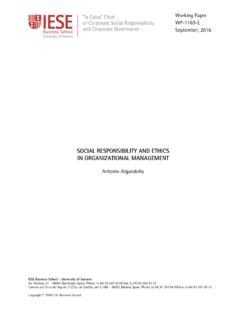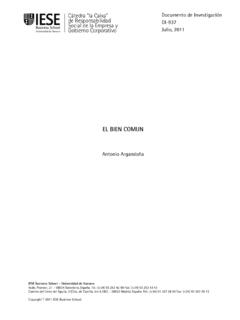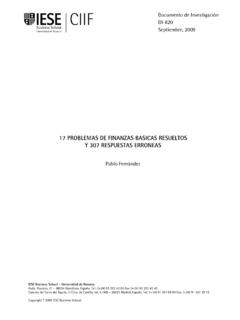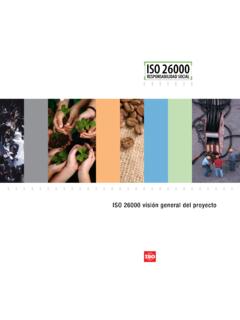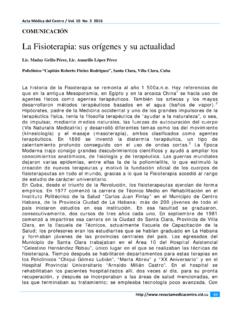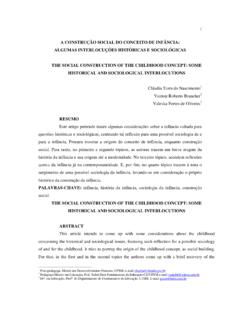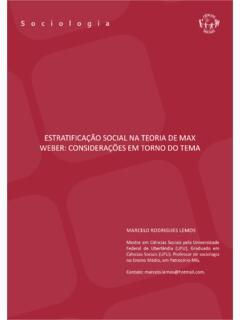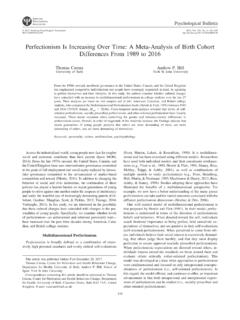Transcription of IESE Cities in Motion Index
1 IESEC ities in MotionIndex2020 iese Cities in Motion IndexDOI: gratefully acknowledge the financial support of the Agencia Estatal de Investigaci n (AEI) of the Ministry of Economy and Competitiveness ECO2016-79894-R (MINECO/FEDER), Ministry of Science and Innovation PID2019-104679RB-I00, the Schneider-Electric Sustainability and Business Strategy Chair, the Carl Schroeder Chair in Strategic Management and the iese s High Impact Projects initiative (2017/2018).Foreword07 About us 10 Working Team 10 Introduction: The Need for a Global Vision 11 Our Model: Cities in Motion .
2 Conceptual Framework, Definitions and Indicators 13 Limitations of the Indicators 25 Geographic Coverage 25 Cities in Motion : Ranking 27 Cities in Motion : Ranking by Dimension 30 Cities in Motion . Regional Distribution 42 Cities in Motion . Regional Ranking 44 Noteworthy Cases 50 Cities in Motion . Evolution 64 Cities in Motion Compared With Other Indexes 67 Cities in Motion : Ranking of Cities by Population 68 Cities in Motion : Analysis of Dimensions in Pairs 72 Cities in Motion : A Dynamic Analysis 79 Recommendations and Conclusions 81 Appendix 1. Indicators 83 Appendix 2.
3 Graphical Analysis of the Profiles of 174 Cities 88 All of the material contained in this document has been developed by the authors unless otherwise Business School - iese Cities in Motion Index 2020 / ST-542-E7 ForewordWe are pleased to present our publication, iese Cities in Motion Index (CIMI), for the seventh consecutive year. As a result of the COVID-19 health crisis, this edition finds us at a peculiar moment in history. With bewilderment, we observe how Cities around the world are left deserted, their streets emptied of their usual daily sounds. Many of the recommendations that urban managers have been calling for in recent years no longer make sense.
4 The quest for better population density rates has been replaced by social distancing; the use of public transportation is discouraged, with the use of private vehicles promoted in its place; instead of enjoying social interaction in squares and common spaces, we are confined to our homes; and the mantra of our Cities in Motion initiative stands as a mere wish rather than a reality. We trust that this situation will be resolved as soon as possible and that our Cities usual vitality and dynamism will soon become part of our lives once this context, we will be repeatedly hearing about, in city forums, the concept of urban resilience or the ability of Cities to overcome traumatic circumstances.
5 Although our Index CIMI does not capture the circumstances of the health crisis, since its indicators are from 2019 and earlier, we believe that it helps identify the main pillars which Cities can adapt positively to these new adverse situations. Our study can be used as a reference for understanding the reality of Cities and the aspects on which to base their recovery, as well as for identifying their most vulnerable facets. Every year we try to improve how we build our Index , and this seventh edition is no exception. We have tried to provide an Index that is comprehensive, wide-ranging and guided by the criteria of conceptual relevance and practical utility.
6 In this sense, this year we have increased the number of variables in relation to the Cities . This edition includes a total of 101 indicators (five more than in the previous edition), which reflect both objective and subjective data and offer a comprehensive view of each city. Among the new variables are, for example, the use of the internet for video calls, the rental of bicycles and scooters, and the use of online banking. These new indicators seek a more accurate assessment of the reality of the Cities included in the s important to remember the limitations of the data.
7 On the one hand, there is the problem of some indicators that are only available at the country level and that are approximated at the city level. On the other hand, there are variables that may underestimate the impact of a particular dimension owing to the regulatory aspects or the city s own circumstances. For example, the variables that seek to measure the collaborative economy such as the presence of Glovo or Uber do not take into account all the different types of local initiatives, such as Delivery Club and Yandex in Moscow. Another example is social media measurements: in certain regions, such as China, platforms such as WeChat prevail, but access to its data is restricted.
8 These limitations mean that certain dimensions must be interpreted with caution. In addition, this year, in the search for greater accuracy, one of our main data providers (Euromonitor) has changed its methodology for measuring certain variables. These differences oblige us to remind the reader that the rankings are not directly comparable from one year to another. The inclusion of new Cities and new indicators produces variations that do not necessarily reflect the trajectory of the same Cities over time. In order to be able to study Cities evolution, in each edition we analyze the trend by calculating the Index of the last three years, and this allows us to make more suitable comparisons.
9 As in previous editions, we have merged two dimensions of our conceptual model, which originally took into account 10 key dimensions: human capital, social cohesion, the economy, public management, governance, the environment, mobility and transportation, urban planning, international projection, and technology. We have retained the merger of governance and public management in a single category (called governance ) for two fundamental reasons: in the first place, because there is a certain overlapping between both dimensions that makes it difficult to distinguish between them conceptually and, secondly, because the limited number of city-related indicators that cover each of these dimensions led us to join them together so we have a more reliable measure.
10 We believe that iese Business School - iese Cities in Motion Index 2020 / ST-542-E8this change does not significantly affect the CIMI conclusions, but instead strengthens them. In any case, we continue to strive to obtain more and better indicators that will capture these dimensions and thereby achieve a model which represents greater coverage as well as a growing analytic value. In this respect, your comments and suggestions are always welcome, as they will enable us to make progress. We therefore invite you to contact us through our website: One of this year s innovations is the CIMI Calculator, which will be available on our website.
